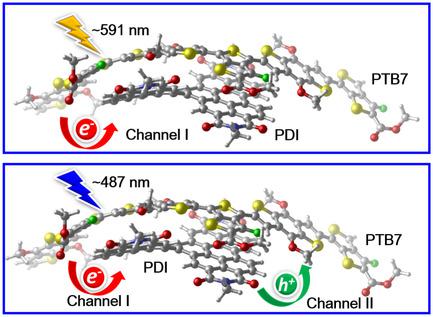Our official English website, www.x-mol.net, welcomes your
feedback! (Note: you will need to create a separate account there.)
Excitation Wavelength‐Dependent Charge Generation Dynamics in a Nonfullerene Organic Solar Cell Interface
Solar RRL ( IF 6.0 ) Pub Date : 2020-12-17 , DOI: 10.1002/solr.202000719 Dong-Hui Xu 1 , Yang Chen 1 , Si-Yuan Zhang 1 , Jia-Li Yu 1 , Xiang-Yang Liu 1 , Laicai Li 1
Solar RRL ( IF 6.0 ) Pub Date : 2020-12-17 , DOI: 10.1002/solr.202000719 Dong-Hui Xu 1 , Yang Chen 1 , Si-Yuan Zhang 1 , Jia-Li Yu 1 , Xiang-Yang Liu 1 , Laicai Li 1
Affiliation

|
Unraveling the charge generation dynamics at the donor–acceptor (D−A) interfaces is crucial for improving the photovoltaic performances of nonfullerene acceptor‐based organic solar cells (OSCs). Herein, time‐dependent density functional theory (TDDFT) based nonadiabatic dynamics simulations are used to explore the ultrafast photoinduced dynamics at a nonfullerene D–A PTB7@PDI interface. Based on the results, it is found that such an interface exhibits distinct charge generation processes upon excitation with different wavelengths. The excitation at ≈591 nm mainly results in the local exciton |PTB7∗>, whereas the charge transfer exciton |PTB7+PDI−> also has minor contribution. Later on, the electron transfer from PTB7 to PDI, i.e., channel I charge generation process, occurs in 1 ps. The situations are much more complex when the excitation is conducted using ≈487 nm light. The initial populated excitons include local excitons |PDI∗>, |PTB7∗>, and charge transfer exciton |PTB7+PDI−>, after which both channel I and channel II charge generation take place ultrafast. However, in both situations, the charge generation processes occur within a few picoseconds, which is consistent with previous experimental work. Such ultrafast charge generation processes in a wide range of solar spectra are one of the reasons responsible for the excellent photovoltaic properties of such OSCs.
中文翻译:

非富勒烯有机太阳能电池界面中依赖于激发波长的电荷产生动力学
阐明供体-受体(D-A)界面上的电荷生成动力学对于提高基于非富勒烯受体的有机太阳能电池(OSC)的光伏性能至关重要。在此,基于时变密度泛函理论(TDDFT)的非绝热动力学模拟被用于探索非富勒烯D–A PTB7 @ PDI界面上的超快光诱导动力学。根据结果,发现这样的界面在以不同的波长激发时表现出不同的电荷产生过程。≈591nm处的激发主要产生局部激子。PTB7 * >,而电荷转移激子| PTB7 + PDI ->也有很小的贡献。随后,电子从PTB7转移到PDI,即通道I电荷产生过程,发生的时间为1 ps。当使用≈487nm的光进行激发时,情况要复杂得多。最初填充的激子包括本地激子| PDI * >,| PTB7 * >,和电荷转移激子| PTB7 + PDI ->之后,通道I和通道II的电荷产生都非常快。但是,在两种情况下,电荷产生过程都在几皮秒内发生,这与以前的实验工作是一致的。在宽范围的太阳光谱中的这种超快速电荷产生过程是造成这种OSC优异的光伏性能的原因之一。
更新日期:2020-12-17
中文翻译:

非富勒烯有机太阳能电池界面中依赖于激发波长的电荷产生动力学
阐明供体-受体(D-A)界面上的电荷生成动力学对于提高基于非富勒烯受体的有机太阳能电池(OSC)的光伏性能至关重要。在此,基于时变密度泛函理论(TDDFT)的非绝热动力学模拟被用于探索非富勒烯D–A PTB7 @ PDI界面上的超快光诱导动力学。根据结果,发现这样的界面在以不同的波长激发时表现出不同的电荷产生过程。≈591nm处的激发主要产生局部激子。PTB7 * >,而电荷转移激子| PTB7 + PDI ->也有很小的贡献。随后,电子从PTB7转移到PDI,即通道I电荷产生过程,发生的时间为1 ps。当使用≈487nm的光进行激发时,情况要复杂得多。最初填充的激子包括本地激子| PDI * >,| PTB7 * >,和电荷转移激子| PTB7 + PDI ->之后,通道I和通道II的电荷产生都非常快。但是,在两种情况下,电荷产生过程都在几皮秒内发生,这与以前的实验工作是一致的。在宽范围的太阳光谱中的这种超快速电荷产生过程是造成这种OSC优异的光伏性能的原因之一。











































 京公网安备 11010802027423号
京公网安备 11010802027423号